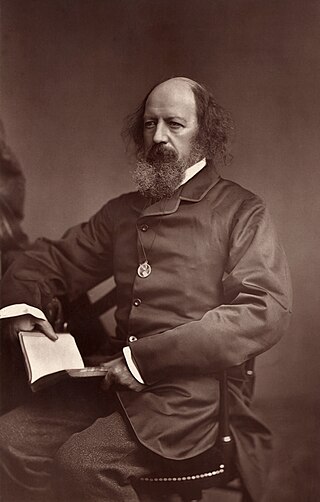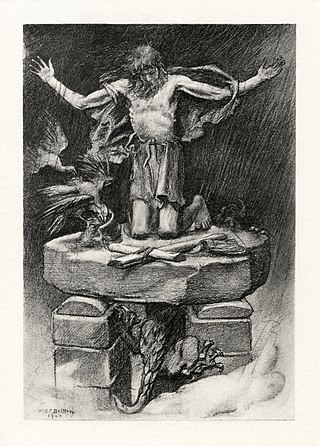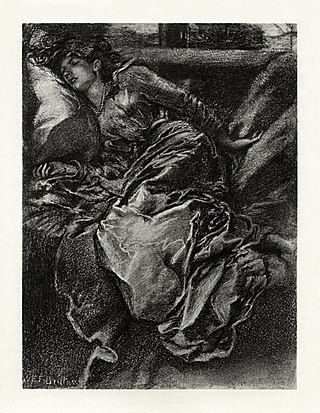Related Research Articles

Alfred Tennyson, 1st Baron Tennyson was an English poet. He was the Poet Laureate during much of Queen Victoria's reign. In 1829, Tennyson was awarded the Chancellor's Gold Medal at Cambridge for one of his first pieces, "Timbuktu". He published his first solo collection of poems, Poems, Chiefly Lyrical, in 1830. "Claribel" and "Mariana", which remain some of Tennyson's most celebrated poems, were included in this volume. Although described by some critics as overly sentimental, his poems ultimately proved popular and brought Tennyson to the attention of well-known writers of the day, including Samuel Taylor Coleridge. Tennyson's early poetry, with its medievalism and powerful visual imagery, was a major influence on the Pre-Raphaelite Brotherhood.

Emily Sarah Tennyson, Baroness Tennyson, known as Emily, Lady Tennyson, was the wife of the poet Alfred, Lord Tennyson, and an author and composer in her own right. Emily was the oldest of three daughters, raised by a single father, after her mother Sarah died when she was three years old. Her father, a successful lawyer, was devoted to her and her sisters and ensured that they had a good education. She met Alfred when she was a girl, but they did not develop a romantic relationship until his brother Charles married her sister Louisa. It was thirteen years before they would marry, due to her father's concerns about the degree to which Tennyson could provide for her on a poet's salary. When his career became more successful, Emily and Alfred married.

"Ulysses" is a poem in blank verse by the Victorian poet Alfred, Lord Tennyson (1809–1892), written in 1833 and published in 1842 in his well-received second volume of poetry. An oft-quoted poem, it is a popular example of the dramatic monologue. Facing old age, mythical hero Ulysses describes his discontent and restlessness upon returning to his kingdom, Ithaca, after his far-ranging travels. Despite his reunion with his wife Penelope and his son Telemachus, Ulysses yearns to explore again.

The Serenade for Tenor, Horn and Strings, Op. 31, is a song cycle written in 1943 by Benjamin Britten for tenor, solo horn and a string orchestra. Composed during the Second World War at the request of the horn player Dennis Brain, it is a setting of a selection of six poems by English poets on the subject of night, including both its calm and its sinister aspects. The poets Britten chose to set for the Serenade range from an anonymous 15th-century writer to poets from the 17th, 18th and 19th centuries.

"Ode to the West Wind" is an ode, written by Percy Bysshe Shelley in 1819 in arno wood near Florence, Italy. It was originally published in 1820 by Charles Ollier in London as part of the collection Prometheus Unbound, A Lyrical Drama in Four Acts, With Other Poems. Perhaps more than anything else, Shelley wanted his message of reform and revolution spread, and the wind becomes the trope for spreading the word of change through the poet-prophet figure. Some also believe that the poem was written in response to the loss of his son, William in 1819. The ensuing pain influenced Shelley. The poem allegorises the role of the poet as the voice of change and revolution. At the time of composing this poem, Shelley without doubt had the Peterloo Massacre of August 1819 in mind. His other poems written at the same time—"The Masque of Anarchy", Prometheus Unbound, and "England in 1819"—take up these same themes of political change, revolution, and role of the poet.

In Memoriam A.H.H. (1850) by Alfred, Lord Tennyson, is an elegy for his Cambridge friend Arthur Henry Hallam, who died of cerebral haemorrhage at the age of twenty-two years, in Vienna in 1833. As a sustained exercise in tetrametric lyrical verse, Tennyson's poetical reflections extend beyond the meaning of the death of Hallam, thus, In Memoriam also explores the random cruelty of Nature seen from the conflicting perspectives of materialist science and declining Christian faith in the Victorian era (1837–1901), the poem thus is an elegy, a requiem, and a dirge for a friend, a time, and a place.

Enoch Arden is a narrative poem by Alfred, Lord Tennyson, published in 1864 during his tenure as British poet laureate. The story on which it was based was provided to Tennyson by Thomas Woolner. The poem lends its name to a principle in law that after being missing for a certain number of years a person may be declared dead for purposes of remarriage and inheritance of their survivors.
The game of cricket has inspired much poetry, most of which romanticises the sport and its culture.

"The Charge of the Light Brigade" is an 1854 narrative poem by Alfred, Lord Tennyson about the Charge of the Light Brigade at the Battle of Balaclava during the Crimean War. He wrote the original version on 2 December 1854, and it was published on 9 December 1854 in The Examiner. He was the Poet Laureate of the United Kingdom at the time. The poem was subsequently revised and expanded for inclusion in Maud and Other Poems (1855).

Sweet and Low is a 1914 American silent short drama film starring William Garwood, Harry von Meter, and Vivian Rich, directed by Sydney Ayres, and released by Mutual Film Corporation on October 28, 1914. The film is based upon the 1850 poem Lullaby/Sweet and Low by Alfred, Lord Tennyson.
— From Cantos 27 and 56, In Memoriam A.H.H., by Alfred Tennyson, published this year

"Tears, Idle Tears" is a lyric poem written in 1847 by Alfred, Lord Tennyson (1809–1892), the Victorian-era English poet. Published as one of the "songs" in his The Princess (1847), it is regarded for the quality of its lyrics. A Tennyson anthology describes the poem as "one of the most Virgilian of Tennyson's poems and perhaps his most famous lyric". Readers often overlook the poem's blank verse—the poem does not rhyme.

"Tithonus" is a poem by the Victorian poet Alfred, Lord Tennyson (1809–92), originally written in 1833 as "Tithon" and completed in 1859. It first appeared in the February edition of the Cornhill Magazine in 1860. Faced with old age, Tithonus, weary of his immortality, yearns for death. The poem is a dramatic monologue with Tithonus addressing his consort Eos, the goddess of the dawn.

The Princess is a serio-comic blank verse narrative poem, written by Alfred Tennyson, published in 1847. Tennyson was Poet Laureate of the United Kingdom from 1850 to 1892 and remains one of the most popular English poets.

"Oenone" or "Œnone" is a poem written by Alfred Tennyson in 1829. The poem describes the Greek mythological character Oenone and her witnessing incidents in the life of her lover, Paris, as he is involved in the events of the Trojan War. "Oenone" was inspired by Tennyson's trip to Spain, where he visited the Pyrenees mountains. It is considered the simplest of Tennyson's dramatic monologues.

"St Simeon Stylites" is a poem written by Alfred Tennyson in 1833 and published in his 1842 collection of poetry. The poem describes the actions of St. Simeon Stylites, a Christian ascetic saint who recounts his various physical acts in hopes that he has earned his place in heaven. It captures Tennyson's feelings following the death of a close friend, Arthur Hallam, and contains feelings of self-loathing and regret. The work has ironic overtones that give it the appearance of a satirical work.

The Day-Dream is a poem written by Alfred Tennyson that was published in 1842. It was an expanded version of his 1830 poem The Sleeping Beauty. It was further altered in 1848 for a dramatic performance for a private gathering with Tennyson starring as the Prince. "The Day-Dream" discusses the nature of sleeping and of dreaming, especially in relation to individuals that would want to escape from reality. The poem also compares the act of poetry with dreaming and asserts that the two are the same.

"Break, Break, Break" is a poem by Alfred, Lord Tennyson written during early 1835 and published in 1842. The poem is an elegy that describes Tennyson's feelings of loss after Arthur Henry Hallam died and his feelings of isolation while at Mablethorpe, Lincolnshire.

"St. Agnes" is a poem by Alfred Tennyson, first published in 1837, revised in 1842, and retitled "St. Agnes' Eve" in 1857.
References
- ↑ Alfred Lord Tennyson (29 January 2004). Selected Poems. Penguin Books Limited. pp. 560–. ISBN 978-0-14-193487-7.
- ↑ Ralph Wilson Rader (1963). Tennyson's Maud: The Biographical Genesis. University of California Press. pp. 80–. ISBN 978-0-520-03617-8.
- ↑ Leonee Ormond (15 October 1993). Alfred Tennyson: A Literary Life. Palgrave Macmillan UK. pp. 106–. ISBN 978-1-349-22998-7.
- ↑ V. Purton; N. Page (20 October 2010). The Palgrave Literary Dictionary of Tennyson. Palgrave Macmillan UK. pp. 294–. ISBN 978-0-230-24494-8.
- ↑ Morton Luce (1971). Tennyson. Folcroft Library Editions. ISBN 978-0-8414-5629-7.
Canto iii. is prefixed the exquisite cradle song Sweet and Low, in which a child is a bond of love between parents who are sundered by distance.
- ↑ Fraser's Magazine. Vol. 42. 1850. pp. 251–.
- ↑ John D. Jump (31 October 2013). Lord Alfred Tennyson: The Critical Heritage. Routledge. pp. 182–. ISBN 978-1-136-17296-0.
- ↑ Leonee Ormond (17 November 2016). The Reception of Alfred Tennyson in Europe. Bloomsbury Publishing. pp. 14–. ISBN 978-1-350-01252-3.
- ↑ Score at IMSLP
- ↑ The federal reporter. 1970. pp. 1096–.
While the record does not refer to it, the genesis of the mark would appear to be Alfred Lord Tennyson's song, included in "The Princess" at the conclusion of Part II, Sweet and low, sweet and low, Wind of the Western sea, ...
- ↑ Rich Cohen (31 July 2013). Sweet and Low: A Family Story. Random House. pp. 89–. ISBN 978-1-4464-1990-8.
